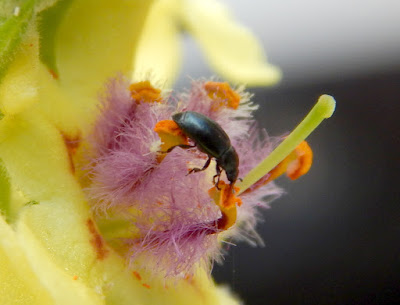 |
| Pollen Beetle (Meligethes aeneus) |
So, here are the facts:
 |
| On a Feverfew flower |
- There are 16 different families that are counted in the name 'Pollen Beetles'. The real name for them is Coleopatra. (No, not Cleopatra. That's completely different!)
- Now, I don't need to tell you what their name means as it`s pretty obvious. But I will. Basically they feed on an awful lot on pollen!
- The usual victims (and victors) of pollen beetles are Sweet Peas, Runner Beans, Narcissuseseses (lol) and Roses. They rather liked the Verbascum in my garden too.
- The most common one is the one that some people call the 'Thunderbug'. There are lots of others that are black, yellow and all sorts of combinations of the two.
- These Pollen Beetles in the photo are only about 2mm - 3mm long! They are black and dark green and look rather shiny.
 |
| Sharing the Verbascum with hoverflies |
- They're very common at a couple of points in the year. After hibernating they emerge to feed mate and lay eggs so you first see them between March and May.
- They start to lay eggs from April and larvae emerge in May and June before the adults are on the wing again in July and August.
- It seems they hibernate after August and that seems a long hibernation.
- I found a lot of information on how to control them when searching as it seems the larvae are a bit of a pest to farmers and they do eat crop but some Gardeners don't like them but the adults don't harm the flowers the feed on and in fact help pollination.
- They are attracted to the colour Yellow so are often seen chomping on pollen in fields of Oil Seed Rape.
 |
| Also see them out and about - here on a bit of unusual pink Hogweed at Silton Forest (zoom in required) |
- In Cambridge there was a swarm of these little critters during the last summer - literally billions of them descended.
- They didn't do any damage but there were lots of reports of people being hit in the face by them when they were on their bikes!
Here are some links to some more information:
Hope you enjoyed,
Z.
Lovely post and these photos are stunning Zach! - Tasha
ReplyDelete